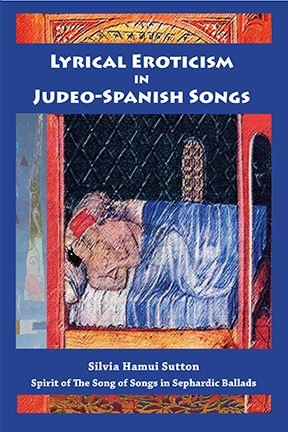Lyrical Eroticism in Judeo-Spanish Songs
Comment by Susana Weich-Shahak
Jewish Music Research Centre, The Hebrew University of Jerusalem
The basic thesis of this suggestive book is that song texts are a mirror of a specific ethos that show an underlying meanings of an specific time, through hidden symbols in the words of the song. A thorough study on the connections of symbols related to the social reality and values shows Spanish Medieval tradition as the roots of the Judeo Spanish songs. In the author’s words, the Judeo Spanish songs are “part of the popular Spanish lyric of the Middle Ages”. Symbols of nature elements date back to the origin of Spanish lyrics, so that the Sephardic songs are variations of the Penninsular Spanish songs, the popular songs that were known to the Jews before their expulsion, and therefore before the literary writings in the Spanish Golden Age, which however, the author includes as examples to complement the interpretation of symbols.
The author shows, in Spanish texts and their English translations, the relationships between themes and literary motifs in the Judeo-Spanish songs’ texts and the Spanish medieval lyrics, marking also the cultural background for each tradition and, furhter more, the relationships between songs’texts and the customs, values and beliefs of the society in which they were sung. Song texts deal with deeply rooted ethical standards, but also with non conformity with the traditionally imposed rules. Very clear are the links that the author shows in ethnographic details about Christian customs coincident with Jewish festivities.
The book includes a wide Introduction on the History of the Jews and specifically about the Jews living in Christian and Moslem Spain, as well as portraying the Sephardic communities formed after their exodus from the Iberian Peninsula. A wise decision of the author was to show a selection of texts from the repertoir of various Sephardic communities, thus emphazising the processes of vitality, innovation and mobility in oral tradition.in the different geographic zones. Accordingly, the author shows the difference between the lyrics of Eastern Sephardim and those from Northern Africa, explained by the geographical and political circumstances in each area. The Sephardic examples are drown mainly from three sources: the publications of Manuel Alvar, of Margarite Frenk and of Matilda Cohen Sarano. The Sephardic materials presented comprise both, lyric and narrative songs, i.e., from both, the Judeo Spanish Cancionero and from the Romancero.
By all means, a book highly recommended, as it will hold the attention not only of those interested in Hispanic literature but also of all the lovers of the Sephardic poetic oral tradition.
Back to Lyrical Eroticism in Judeo-Spanish Songs
Gaon Books
Sephardic Traditions

